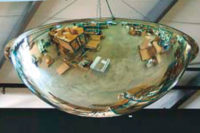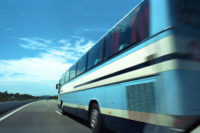Vision and clarity
Now there is a solution for convex mirrors that need a wider 180-degree viewing angle, without jeopardizing the clarity of the mirror.
The forming procedure limits the curvature of the mirror to half of the depth of a standard mirrored dome, reducing the distortion of the standard dome viewing results. A flat flange area provides a rigid stability to the mirror, especially for outdoor models.
There is a benefit to a second category of mirrors, a supplement to a line of mirrored domes used at problem intersections. Sometimes an overhead restriction prohibits the installation of a full dome in a 4-way or 3-way intersection. The 180-degree viewing properties of these mirrors provide a view from three different directions with more clarity than a standard dome. These mirrors are mounted with a telescoping bracket and usually at a lower position with a much clearer eye-level viewing angle.
Outdoor applications
The mirrors provide a solution for another old problem: Intersections in outdoor applications. Domes are not typically used outdoors due to the weather-related problems or a suitable location to properly mount the mirror. There are many blind corners and unguarded intersections that need a warning of approaching vehicle traffic or pedestrians. A standard convex mirror will provide a brief view of a specific angle around a corner until the driver passes the prime viewing angle of the mirror. The 180-degree viewing angle gives the driver a view beyond the immediate intersection, further down the aisle or path of traffic.
The new mirrors can be mounted on a pole, rack or wall of an outside structure. With the telescoping bracket mounting system, positioning of the mirror is flexible to provide the best possible angle for maximum warning. Mirrors positioned at a 6-9 foot height will bring the viewing image down to eye-level for the most natural angle when approaching an intersection.
Mirror options meet market needs
Mirrors come in 16 inches, 24 inches and 32 inches, in both indoor and outdoor models with hardware included. Standard material used for the mirror itself is acrylic, but special orders can be processed for alternate materials such as PETG or Polycarbonate.
Distribution center managers have found that bringing the viewing level down to eye-level has provided forklift operators with a more immediate warning of pedestrians and other moving vehicles. Warehouse forklift traffic is generally higher paced than a production facility and the larger mirrors at the lower mounted positions provide a better warning than mirrored domes suspended 10-15 feet above the intersection.



